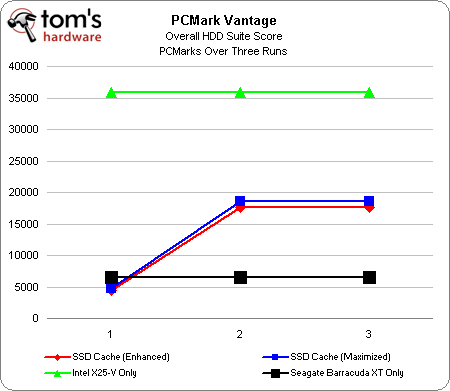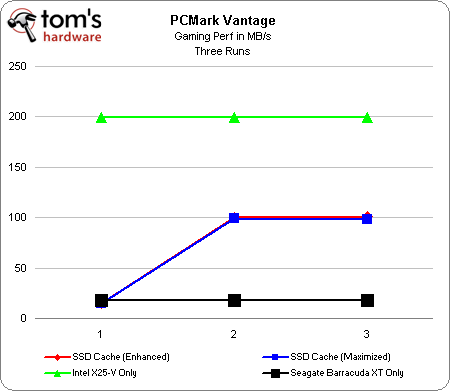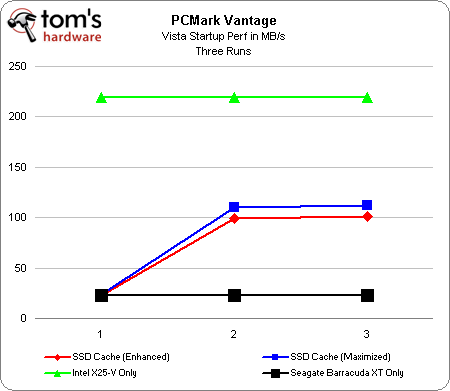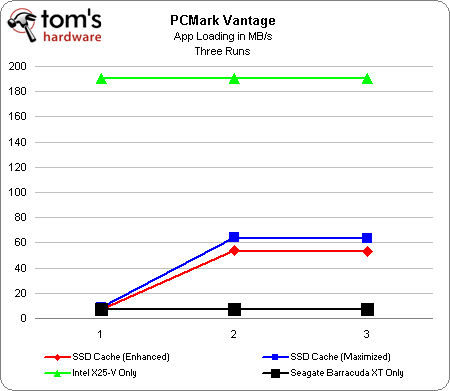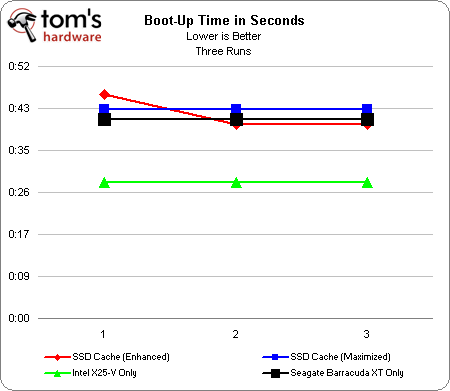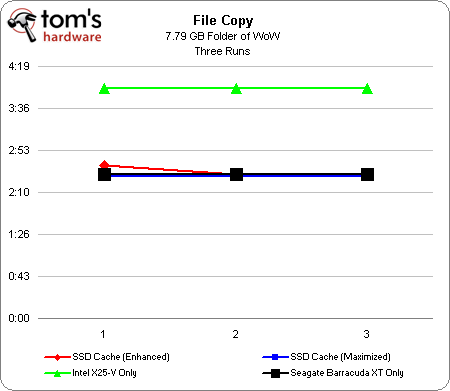Intel Z68 Express Chipset Preview: SSD Caching And Quick Sync
Enthusiasts were forced to hit the brakes on Sandy Bridge when motherboard vendors massively recalled platforms based on Cougar Point. We take a Z68 Express-based board for a spin to see if you should wait for Intel's true LGA 1155 enthusiast chipset.
Benchmark Results: PCMark Vantage, Boot-Up, And File Copy
The performance of an SSD and a hard drive serve as the ceiling and floor in PCMark’s overall HDD suite. You’ll notice, though, that the first run on the cached configurations is actually slowest of all. However, it takes just one repetition of PCMark to demonstrate the gains made possible using the technology. And given a cache of up to 64 GB, there’s a strong chance that the information you access most often will end up resident on the SSD.
I didn’t graph out every single sub-test from the HDD suite, since they all demonstrate a similar trend. Basically, you get performance slightly lower than a baseline hard drive-only run at first, as the system writes to both SSD and HDD. Then, subsequent accesses come from the SSD, facilitating significantly better performance.
The Maximized cache setting makes its most pronounced difference in the Vista startup benchmark. But we maintain that it’s not worth risking data loss to use the write-back setting.
Read performance from Intel’s X25-V is one of its strengths, and we see the App Loading test push the upper limits of what this SSD can do on its own. Naturally, the first run with caching enabled doesn’t give us any performance benefit, but by the second run through Vantage, we see a pretty solid performance increase.
The effect of caching on boot-up is, unfortunately, pretty minimal. The bare SSD is the benchmark to beat—everything else is roughly equivalent to a Seagate Barracuda XT on its own.
Intel’s documentation claims that caching helps read and write performance. But in Enhanced mode, you’re writing to the cache and hard drive simultaneously, so you’ll really only ever realize improved read performance.
It doesn’t help that the budget-oriented SSDs that’ll be used for caching aren’t the fastest. Intel’s X25-V boasts 170 MB/s reads, but its sustained sequential writes are a paltry 35 MB/s. The Barracuda’s maximum outside-diameter data rate of 138 MB/s gives it a distinct advantage.
Get Tom's Hardware's best news and in-depth reviews, straight to your inbox.
That advantage plays out in our file copy benchmark, where we copy a 7.79 GB folder full of files containing the World of Warcraft game to the same drive. This happens fastest on the Barracuda. Incidentally, when we move the folder over to a configuration consisting only of the X25-V, the copy operation takes significantly longer.
Current page: Benchmark Results: PCMark Vantage, Boot-Up, And File Copy
Prev Page Intel Makes Caching Easy Next Page Lucidlogix Virtu, Revisited-
aliened Nice. Thanks for the quick heads up, I was just starting to build my new rig but now that I read this I'm going to wait for the Z68 MOBOs :DReply -
compton I am one of those ssd+hdd users who prefer manually managing the drives. Recently I discovered some of the older ssd + hdd cache devices(Silverstone made one). I wasn't impressed. However,I could see the Intel cache set-up as being advantageous for me. Why? I have a boot SSD, large storage HDD, and a third SSD. I could still boot from the boot drive, then use the second SSD and HDD together. I like that idea enough to wait for the Z chipset before I ditch the H chipset.Reply -
cangelini compton, problem with that SilverStone unit was that it didn't have any intelligence built-in--it was simply mapping the first sectors of the hard drive, if what I remember reading a year ago was right...Reply -
Crashman Excellent Work, Mr Angelini! Now it's my job to make sure the motherboard manufacturers follow through!Reply
-Your Adversarial Colleague -
haplo602 wow ...Reply
I am thinking what is more restricting ... a ZFS supporting OS or the stupid Intel list for SSD caching.
The only impresive part of Sandy Bridge is the single-threaded performance. Everything else is a disaster (chipsets, QuickSync restrictions, price, linux drivers and bugs etc.) or was already available in previous generations.
Waiting on AMD Bulldozer and Llano ... I just hope those 2 won't be similar disasters. -
Crashman haplo602wow ... I am thinking what is more restricting ... a ZFS supporting OS or the stupid Intel list for SSD caching.The only impresive part of Sandy Bridge is the single-threaded performance. Everything else is a disaster (chipsets, QuickSync restrictions, price, linux drivers and bugs etc.) or was already available in previous generations.Waiting on AMD Bulldozer and Llano ... I just hope those 2 won't be similar disasters.In regards to Linux, isn't that like saying "Toyotas are junk because they're always dirty"? I mean, Linux is maintained by its "owners".Reply
-
So would ssd caching work on a raid 0 setup with 2 samsung spinpoint F3's or would this add an additional risky element without much performance gain?...or say a raid 1 where I have backup...would it cache both drives or 1?..Sorry new to this and also waiting for a z68.Reply
-
cangelini tradeshowhoundSo would ssd caching work on a raid 0 setup with 2 samsung spinpoint F3's or would this add an additional risky element without much performance gain?...or say a raid 1 where I have backup...would it cache both drives or 1?..Sorry new to this and also waiting for a z68.Reply
Yes, so long as all members of the array are hard disks.
